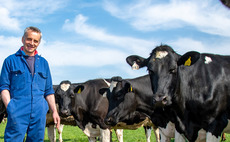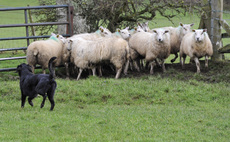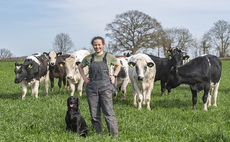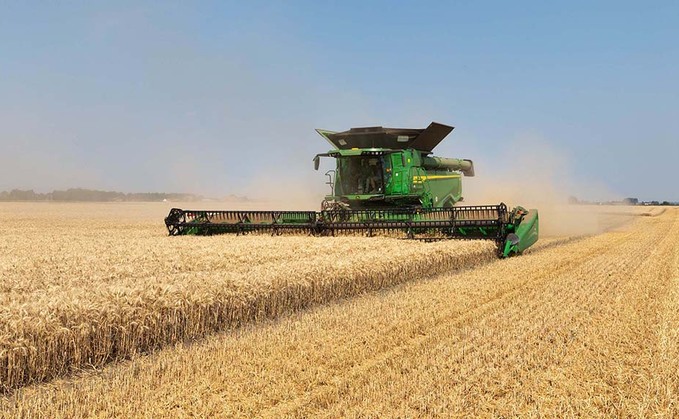
Boasting 100 tonnes per hour with only 1 per cent losses, one of the most highly anticipated recent combine developments has to be John Deere's new X9. James Rickard caught up with the machine in action.
Brand new from the ground up, John Deere's latest X9 combine series represents more than just a new combine development, but a complete change of mind set for its engineers which worked on the project. Encouraged to no longer think in the traditional ways of building farm machinery, but rather employ a more fanatical, aerospace approach to its engineering techniques. This has seen every millimetre of space, every watt of power and every gram of weight questioned and scrutinised, adding up to some impressive efficiency and throughput gains over its current S Series flagship.
Key developments include a new twin rotor threshing system, cleaning shoe, wider body, headers, engine, transmission, power transfer and residue management system.
Two models make up the new X9 Series; the 639hp X9 1000 and 700hp X9 1100. These sit above the current S Series, which will remain in the manufacturer's line-up.
Compared to the top, 625hp S790 model, the new models are claimed to have a greater throughput in ‘tough' wheat of 34 and 70 per cent respectively, and 35 and 40 per cent in OSR. And while the smallest X9 has only 1 per cent more power than the S790, both new machines have a 45 per cent larger threshing area, 36 per cent larger cleaning area, 23 per cent wider harvesting body (crop channel), but all squeezed into the same transport width - 3.5m on 610mm tracks.
X9 Series overview
Model | X9 1000 | X9 1100 |
Maximum power | ||
Grain tank capacity | 14,800 litres | 16,200 litres |
Combine list price | £675,033 | £724,908 |
HD40X (12.2m) header list price | £124,420 | £124,420 |
Threshing and separating
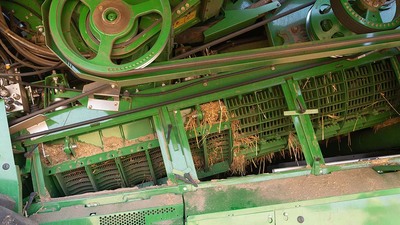
Building on its Tri-Stream rotor technology, as used in its S Series combines for the last 20 years, the two, 610mm diameter rotors in the X9 are longer at 3,510mm and feature 150mm wider inlet flighting. The latter, along with a chevroned feed rotor, allows for greater feeding and minimal compression, delivering 270 degrees of feeding designed to more evenly deliver crop into the rotors.
Towards the back of the rotors, tine pattern has also been improved for a better crop flow, with more grain able to escape thick crop mats, according to Deere.
Each rotor features 15 threshing elements, offering a 45 per cent greater threshing area compared to the S790. Similarly, separation area is up 80 per cent. In total, crop revolves around the rotors a total of nine and a half times; 2.5 times in the threshing area and seven times in the separation portion.
A three-stage rotor chamber allows the crop to expand as it passes along the rotor, along with the rifled threshing elements and separation tines.
Underneath, concaves are adjusted and held in place hydraulically. Seemingly unafraid of lumps and potential blockages, the X9 uses ‘active' hydraulics to hold the concaves in position, rather than allowing them to flex. This sees concave distance maintained, which Deere says offers a better threshing performance.
At the back of the rotors, eight-wing discharge beaters offer additional separation while delivering crop to the chopper. They have also been designed to better handle tricky crops like linseed.
Two sensors per rotor offer improved grain loss sensing, offering an independent left and right reading via the in-cab Vision Track Display.
Cleaning and grain handling
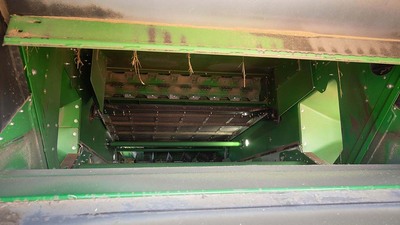
At 7m.sq, the cleaning shoe offers a 36 per cent greater cleaning area over the S790.
Replacing the shoe augers, its front, stepped pan is designed to handle more capacity. At this stage, the combine can already begin to separate grain from foreign material before reaching the front chaffer.
Working on a high volume, low pressure principal, air flow is also boosted by 85 per cent, via four turbine fans, generating improved full width air flow distribution.
To improve grain quality and reduce losses in rolling terrain, the X9 features Deere's Active Terrain Adjustment system which automatically adjusts the combine's sieve and chaffer openings and controls the cleaning fan speed, stabilising tailings levels.
It also gets the firm's Active Tailings Return system, which distributes material back to the return pan, without having to go back through the main threshing area.
Across the width of the cleaning shoe, are six total loss sensors; one per bay.
Up top, the X9 1000 gets a grain tank size of 14,800 litres, while the larger X9 1100 gets a 16,200 litre tank. Peak unloading rates are 162 and 186 litres/second, respectively.
Unloading auger length options include 8.3, 8.7 and 9.3m.
Residue system
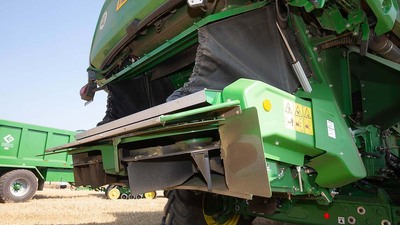
Bringing up the rear is a new residue handling system. Designed with a large focus on airflow and the reduction of back pressure within the combine, the chopping knives feature a clever dimple pattern, which disrupts the airflow, allowing it to travel past the knives and out the back of the combine.
Air is further drawn out of the combine via the spreading discs' double decker construction, where the upper portion serves to draw air out of the combine. This is helped by larger air vents to the sides of the combine. The lower portion of the discs are then dedicated to the spreading of material.
Spreading discs are mechanically driven, with a fixed speed of 562rpm, which Deere says is more efficient than hydraulically-driven variable drive units. As a result, spread pattern has to be controlled mechanically via vanes which can be moved in and out of position. This can be done from the cab, and can be further automated via the firm's wind control system, which automatically sends more material to one side of the combine based on the direction of travel from the GPS receiver.
The chopper features 124 knives across the full width of the crop flow, and spread pattern can be up to 50m wide.
Header and feeder house
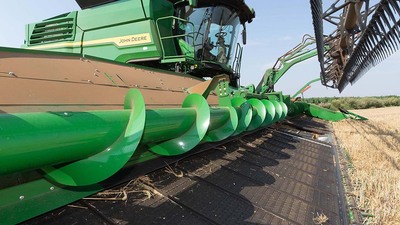
Just as big of a development as the combine is, a lot of Deere's attention has been on the headers, in particular its new HDX range of draper headers. The ultimate aim was not to have the header as a limiting factor, and make the most of combine performance.
The biggest standout feature of the header is its hinged frame design, which allows the wings of the header to move up and down by +/-450mm (on a HD40X 12.2m header). In addition, the split reel design follows the movement of the header, making sure crop is swept into the header throughout the full wing range.
A parallel linkage runs back to the feeder house from the header frame, offering fore and aft tilting, as well as side to side movement - it effectively allows the header to float independently of the combine. Wheels behind the header offer height control and support.
Overall, this allows the header to better follow ground contours, ideal for lodged and downed crops.
Transferring crop to the centre of the header is a 1,200mm-wide belt. This large width, and therefore header depth, is said to be better suited to tall and bushy crops as found in Europe. The belt also features a grid pattern which is designed to reduce losses by keeping grain on the belt.
If you do chew a chunk out of the front of the belt, belts are reversible and can be swapped around.
A large diameter, 460mm diameter top auger aids crop transfer, with its centre sections featuring fingers to better control the flow of bushy crops. Also, a two-speed gearbox on the header can be used to adapt the header to the crop/conditions.
HDX header width options are 10.7, 12.2 and 13.7m, which will also be available for the S Series.
At 1,720mm-wide (internal width), the X9 has the widest feeder house on the market. The aim is to have a wide, flat mat of crop, presenting a more even flow of crop to the threshing rotors.
Up-front is a single position drum, which saves having to adjust it from crop to crop. Feeder house can also be reversed under full throttle, to clear blockages.
Engine and transmission
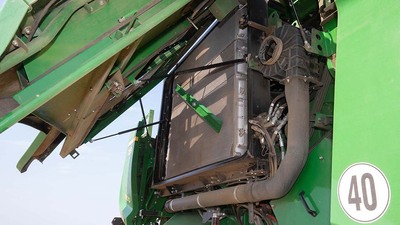
Power for the X9 comes from Deere's new 13.6-litre engine. With 11 per cent more power compared to its old 13.5-litre unit, it is tuned to harvest at 1,900rpm. And once loaded up, it will run quite happily down at 1,700rpm, making the most of those important torque levels.
The cooling package features an auto-reversing fan which reverses every 20 minutes, which as well as cleaning out the radiator, also disrupts any settled dust in the engine bay.
Offering 30 per cent greater torque generation, the X9 gets a new, two stage hydrostatic transmission. For maximum torque below 12kph, both hydro motors are engaged. Above 12kph, one motor is de-clutched, offering greater efficiency at higher speeds.
With a top speed of 40kph, there are no gears to change, with everything done automatically.
Interestingly, for the drivelines, it would appear Deere has been quite conventional. But, according to the firm, it is the greater efficiency afforded by modern materials which has seen the firm gravitate towards the use of belts and pulleys rather than shafts and gearboxes. In all, from the main engine gear case to the feeder house, there are only four power transfer sub-systems, as opposed to seven on the S Series. There are also two chains less.
Overall, between the engine, transmission, drivelines and the new threshing and residue systems, Deere says the X9 offers a 20 per cent fuel saving over the S790. It also means maintenance is easier; there are no daily grease points and only nine, 50 hour grease points and the rest are more than 400 hours.
Cab and technology
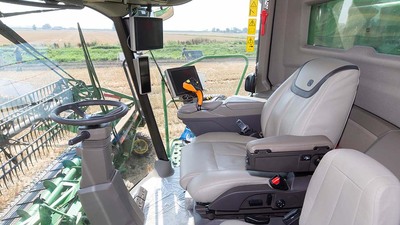
Cab interior, layout and control is similar to the current S Series. New additions include a 7.5 inch touch screen infotainment system, which is fully compatible with Apple Car Play and Android equivalent. And for those operators who have been enjoying Deere's new massage seats, as found on its new 7R and 8R Series tractors, you will be glad to know this is an option for the X9.
Technology-wise, the X9 can be specified with a multitude of toys including Deere's Combine Advisor system and Generation Four Machine Sync. In particular, for a high output combine like this, Combine Advisor is more pertinent than ever, which enables the continuous automatic adjustment of the combine on the move, allowing you to make the most of the combine's capacity.
In addition, Machine Sync allows the combine to take control of the tractor and trailer. Once in range, the combine can control the tractor's forward speed and its distance from the combine. This means you do not have to back off to concentrate on filling the trailer, again, allowing you to make the most of the combine's capacity.
Standard technology includes AutoTrac, JD Link, StarFire 6000 receiver and Connect Mobile Harvest.
Verdict
From our demo-day experience with the X9, it is clear to see JD has put a lot of effort into the combine's development.
Performing more like a self-propelled forager, especially in terms of forward speed and driving style, it soon becomes apparent that its raft of on-board technology and driver aids are now more important than ever, if you are to get the most out of the combine.
From an engineering point of view, you can see that every millimetre is maximised, resulting in a wide crop flow from front to back. And while you might think the combine would be littered with hydraulic motors, the advances in belt technology means much of the driveline is very traditional, all adding up to gains in efficiency.













